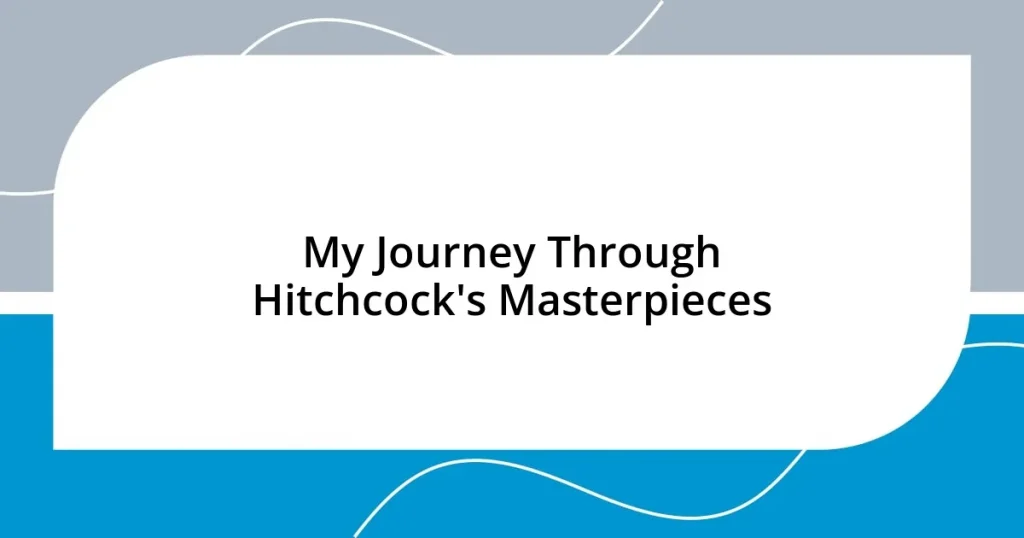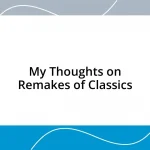Key takeaways:
- Hitchcock’s films blend ordinary lives with psychological depth, exploring themes like identity, voyeurism, and moral conflict.
- Innovative techniques, such as the “MacGuffin” and suspense vs. surprise, revolutionized the thriller genre and influenced future filmmakers.
- Key themes include fear of the unknown, isolation, and the duality of human nature, encouraging viewers to reflect on their own experiences.
- Hitchcock’s character arcs emphasize personal struggle and the complexity of identities, inviting introspection and empathy from the audience.
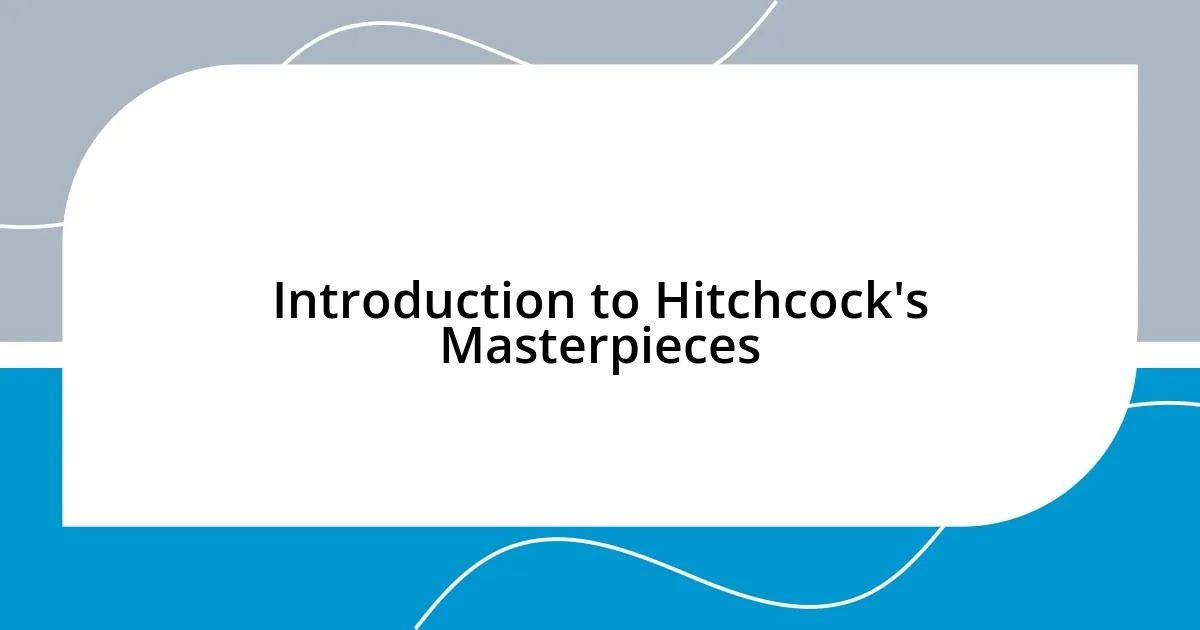
Introduction to Hitchcock’s Masterpieces
Alfred Hitchcock’s masterpieces captivate audiences with their intricate storytelling and psychological depth. I remember the first time I watched “Psycho”; the tension had me on the edge of my seat, making me question everything I thought I knew about fear in cinema. It’s fascinating how Hitchcock uses suspense to create a connection with viewers, drawing them into a world where every glance and shadow tells a story.
What makes Hitchcock’s work so universally appealing? Perhaps it’s his ability to intertwine ordinary lives with extraordinary circumstances, leaving us to ponder the thin veil between normalcy and chaos. When I encountered “Rear Window,” I was struck by how easily I slipped into the role of voyeur alongside Jimmy Stewart’s character, feeling a thrill that made me question my own ethics.
Each film offers a masterclass in psychological tension and unexpected twists, a trademark of Hitchcock’s genius. In “Vertigo,” I found myself entangled in obsession and identity, emotions that left a lasting impression long after the credits rolled. It’s this emotional resonance that makes revisiting his work feel like peeling back layers of a complex puzzle, revealing new insights with each viewing.
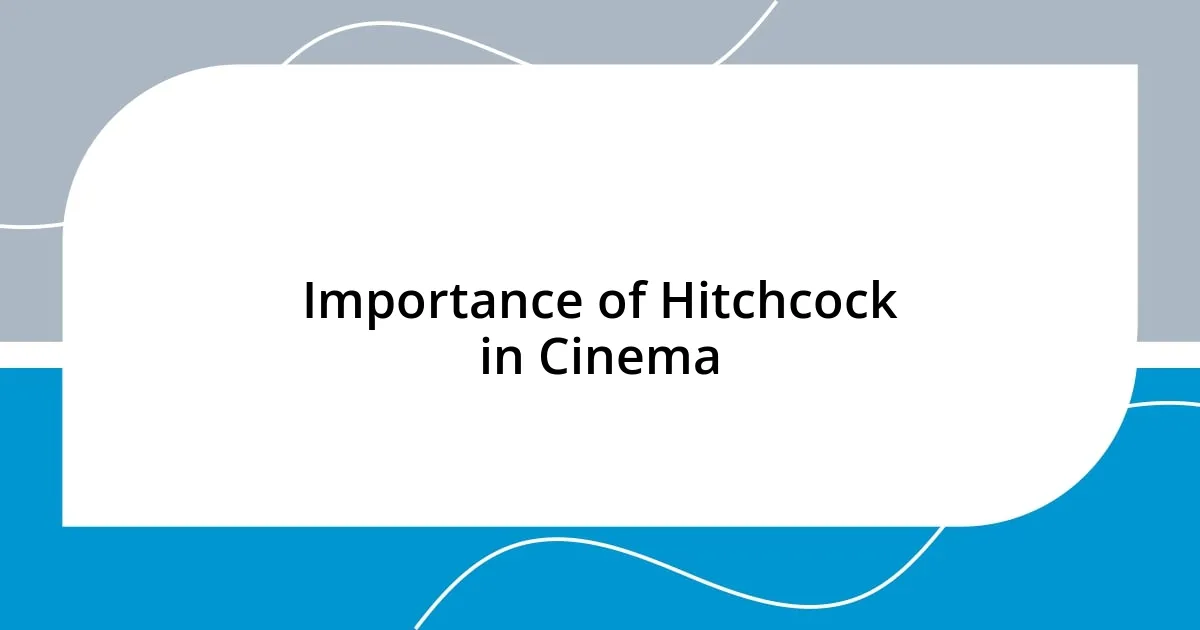
Importance of Hitchcock in Cinema
Hitchcock’s influence on cinema is simply monumental. He revolutionized the thriller genre by employing innovative techniques like the “MacGuffin”—a plot device that drives the story but may not even be crucial to the actual narrative. I vividly recall the way “North by Northwest” uses visual storytelling to manipulate our expectations; the iconic crop-duster scene still sends chills down my spine as it brilliantly plays with suspense and misdirection.
What strikes me most is Hitchcock’s mastery of psychological depth. His characters are often flawed, relatable, and deeply complex, inviting viewers to explore their motivations. For instance, in “Strangers on a Train,” the exploration of guilt and moral conflict resonated with me on a personal level, leaving me pondering the shadows lurking within our own choices. It’s this depth that compels audiences to reflect on their own lives while being entertained.
Hitchcock wasn’t just a filmmaker; he was a pioneer who set the stage for future directors. His ability to blend atmospheric tension with compelling narratives changed how stories were told on-screen. I often think about how modern suspense films owe a debt to his work. The techniques he pioneered continue to challenge and inspire, urging filmmakers to push boundaries and explore the darker sides of human nature.
| Aspect | Hitchcock’s Influence |
|---|---|
| Innovative Techniques | Use of the MacGuffin |
| Character Depth | Flawed, relatable characters |
| Legacy | Paved the way for future directors |
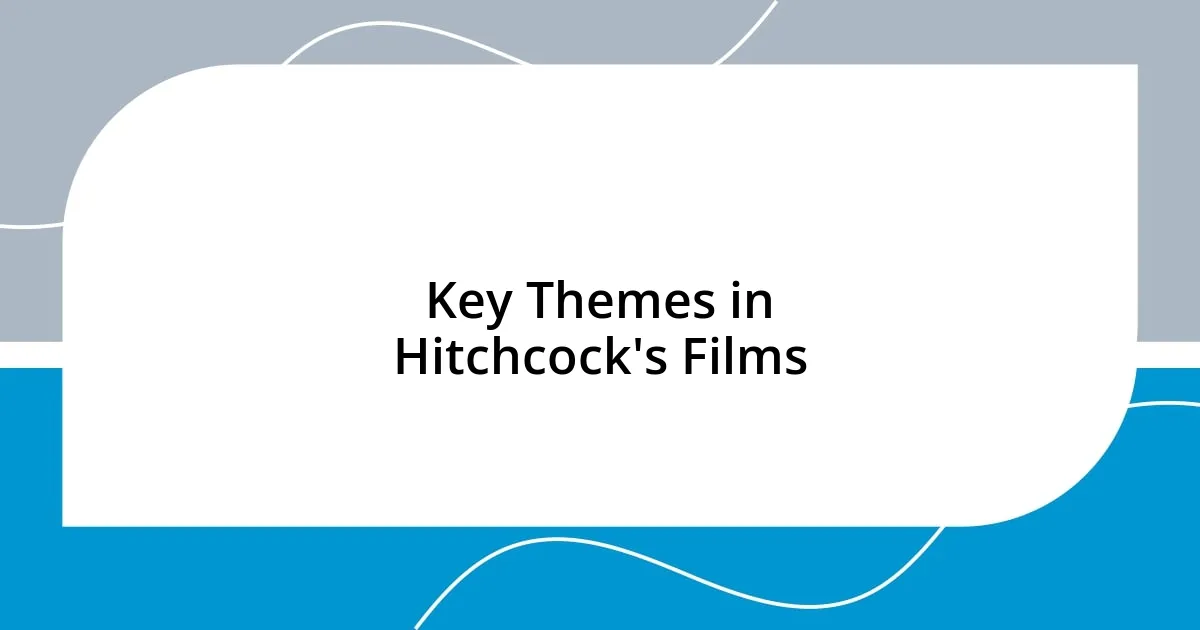
Key Themes in Hitchcock’s Films
Hitchcock’s films are rich with recurring themes that resonate deeply with audiences. One standout theme is the exploration of identity and the psychological complexities that come with it. I remember watching “Psycho” and being struck by Marion Crane’s transformation from a seemingly ordinary woman to the embodiment of fear and paranoia after a fateful decision. It made me reflect on the thin line between who we are and who we might become under pressure.
Another crucial theme is the interplay of voyeurism and surveillance. In “Rear Window,” I felt a shiver of discomfort as my own curiosity mirrored that of Jeff Jefferies. The film cleverly plays with our desire to watch while also challenging the ethics behind it. To really capture Hitchcock’s thematic brilliance, here are a few key elements to consider:
- Fear of the Unknown: The dread of what lies unseen, often heightened by sound and silence.
- Isolation: Characters frequently face peril alone, increasing tension and introspection.
- Guilt and Paranoia: Many protagonists grapple with their own conscience, revealing how guilt can distort perception.
- Voyeurism: The act of watching is both thrilling and morally ambiguous, compelling audiences to reflect on their own tendencies.
- Duality and Deception: Characters often harbor secrets, underscoring the complexities of human nature and the masks we wear.
These themes have a way of lingering in my mind, urging me to reconsider my own experiences and perceptions. The beauty of Hitchcock’s storytelling lies in its ability to blend these themes into a narrative that feels both personal and universally relevant.

Analyzing Iconic Hitchcock Movies
Analyzing Hitchcock’s iconic movies reveals the genius behind his storytelling. Take “Vertigo,” for instance; the way it weaves obsession, identity, and tragedy into a dizzying narrative still leaves me in awe. I recall the first time I watched it—my heart raced as Scottie’s spiraling descent mirrored my own feelings of confusion and yearning. It makes you ask: how well do we really know ourselves and those we love?
Another film that stands out is “The Birds.” The escalating tension of an unexplained avian assault taps into our primal fears, using nature as an unpredictable antagonist. I can still remember the shivers running down my spine during that haunting school scene. It’s fascinating how Hitchcock uses sound design in this film, the absence of a musical score heightening the sense of dread. It begs the question: why is the unknown often more terrifying than what we can see?
Then there’s “Shadow of a Doubt,” which explores the duality of human nature within the framework of an idyllic small-town setting. As I watched, the chilling contrast between the charming façade and the dark secrets lurking beneath made me reflect on the people in my own life. How often do we overlook telltale signs in those we hold dear? Hitchcock brilliantly manipulates our perceptions, urging us to question the veneer of safety that we sometimes take for granted.

Techniques Used by Hitchcock
Hitchcock was a master of suspense, and one of his signature techniques was the use of “suspense vs. surprise.” In “Psycho,” I felt my heart race not just from shocking twists, but from that haunting buildup when I knew what was about to happen, yet the characters remained oblivious. This delicate balance kept me on edge, pondering moments filled with dread long before they unfolded. Have you ever felt that kind of anticipation, where you’re just waiting for the inevitable to strike? It’s both torturous and exhilarating.
Another technique I find fascinating is the use of camera angles and framing to convey psychological tension. In “North by Northwest,” the iconic crop-dusting scene grabbed my attention and held it with relentless precision. The way Hitchcock framed Cary Grant against that vast, empty landscape emphasized his vulnerability. This stark contrast made me question: how often do we feel exposed in our own lives? The visual storytelling lingers with me, illustrating how much our surroundings can reflect our inner turmoil.
Hitchcock’s masterful manipulation of sound also stands out to me. In “The Birds,” the absence of a traditional score lets the eerie silence speak volumes, while the cacophony of birds creates an unnerving atmosphere. I remember absorbing the film in a packed theater, hearing the collective gasps and murmurs from the audience as we braced for what was coming. It made me realize how sound—or the lack thereof—can stir emotions just as strongly as visuals, leaving a lasting impression on our psyche long after the credits roll. Have you ever been captivated by the sounds of a film, feeling them resonate deep within you? It’s in those moments that I truly appreciate the artistry behind his work.
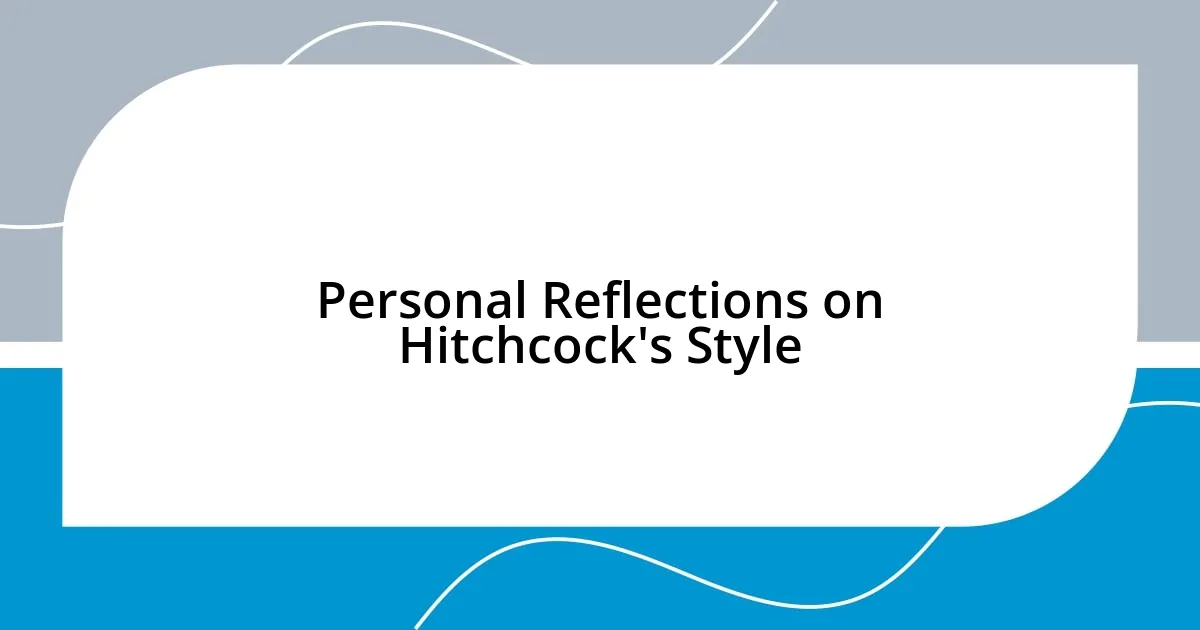
Personal Reflections on Hitchcock’s Style
Hitchcock’s style resonates with me on a deeply personal level, particularly his ability to create suspense through vulnerability. I remember watching “Rear Window” for the first time and feeling my own heart race alongside Jeff’s as he peered into the lives of his neighbors. It’s incredible how Hitchcock forces us to confront our voyeuristic curiosity—how many times have we found ourselves looking into the lives of others, perhaps out of boredom or sheer fascination? This reflection on our own guilt and intrigue is a testament to his art.
What truly captivates me is how Hitchcock plays with the concept of identity. In “Marnie,” the complexities of Marnie’s character made me ponder the masks we wear in society. I found myself leaning closer to the screen, yearning to unravel her secrets while simultaneously reflecting on my personal struggles with identity. How often do we hide parts of ourselves to fit into prescribed roles? His characters embody these intricate layers, compelling us to reflect on our true selves amidst societal expectations.
I also appreciate Hitchcock’s use of color and symbolism, especially in “The Man Who Knew Too Much.” The recurring motif of the song “Que Sera, Sera” struck me as a haunting reminder of the unpredictability of life. I recall humming it softly long after the film ended, contemplating the weight of fate and choice. Isn’t it fascinating how a simple tune can evoke such profound emotions? This layering of sound and narrative not only underlines his mastery but also inspires me to explore the deeper meanings hidden within everyday life.
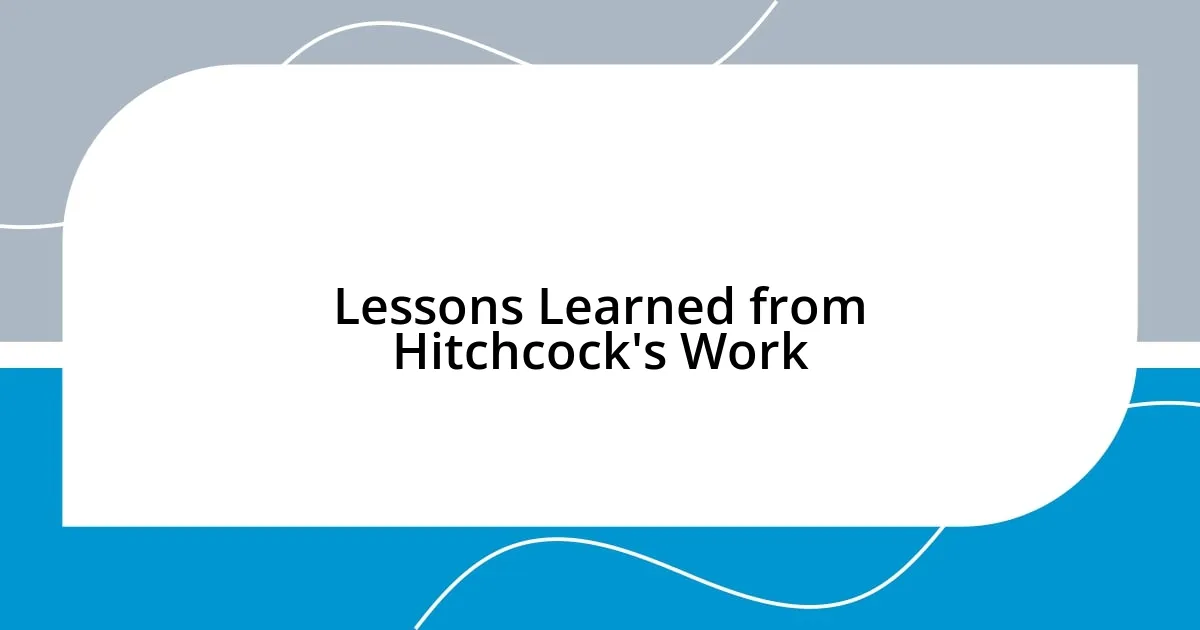
Lessons Learned from Hitchcock’s Work
Hitchcock taught me the art of building tension through expectation. When I first watched “Vertigo,” I felt entranced by the protagonist’s obsession, yet it was the way that anticipation was transformed into a sense of dread—mixing beauty and tragedy—that truly struck a chord with me. Have you ever found yourself torn between fascination and fear in a story? This exploration of nuanced emotions reveals how effective storytelling can evoke complex feelings we often grapple with in real life.
One lesson that resonates deeply is the notion of perspective in storytelling. In “Psycho,” as the narrative shifts from Marion Crane to Norman Bates, I experienced a profound jolt in empathy. The sudden change in focus left me questioning: how can we so easily misjudge people based solely on surface appearances? This shift challenged my preconceptions and reminded me that everyone has hidden layers, much like Hitchcock’s characters.
Hitchcock’s character arcs highlight the struggle against one’s past, which I find compelling. In “Spellbound,” as the characters navigate their psychological traumas, I was reminded of my own experiences—how confronting our fears is often the only way to heal. It made me reflect: what burdens do we carry that shape our identities? This exploration of the human psyche in his films invites an introspective journey, encouraging viewers to embrace their complexities rather than shy away from them.











